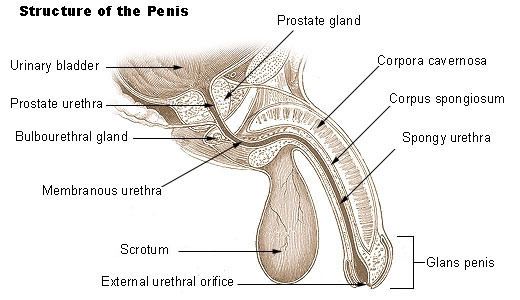Dorlands/Elsevier o_06/12596415 | ||
 | ||
Latin Orificium urethrae externum | ||
The urinary meatus, also known as the external urethral orifice, is the opening or meatus of the urethra. It is the point where urine exits the urethra in males and in females, and also where semen exits the urethra in males. The meatus has varying degrees of sensitivity to touch. The meatus is located on the glans penis in males and in the vulval vestibule in females.
Contents
In human males
The male external urethral orifice is the external opening or urinary meatus, normally located at the tip of the glans penis, at its junction with the frenular delta. It presents as a vertical slit, possibly bounded on either side by two small labia-like projections and continues longitudinally along the front aspect of the glans, which facilitates the flow of urine micturition. In some cases the opening may be more rounded and this can occur naturally or may also occur as a side effect of excessive skin removal during circumcision. The meatus is a sensitive part of the male reproductive system.
Due to the flexibility of the penis and meatus, the stream of urine in the male can be manipulated and targeted. In different cultures different positions of urination are employed. Sitting and squatting are also options to standing to urinate. Also in the elderly male with prostate problems sitting down is preferable. For practising Muslim men, the genital modesty of squatting is also associated with proper cleanliness requirements or awrah.
In human females
The external urethral orifice (urinary meatus) is the external opening of the urethra, from which urine is ejected during urination. It is located about 2.5 cm behind the glans clitoridis and immediately in front of the vagina in the vulval vestibule of the female genitalia. It usually assumes the form of a short, sagittal cleft with slightly raised margins. To its left and right are the openings of the Skene's ducts.
Some evidence exists to suggest that the clitoral-urinary meatus distance (CUMD) in human females relates to the ease with which she may achieve orgasm through penetrative sex. Orgasm from penetration alone is observed to be more likely as CUMD decreases.
Clinical significance
Congenital disorders of the meatus include epispadias – the misplacement to the upper aspect and hypospadias – the misplacement to the underside of the penis. A congenital mis-shaping can result in its narrowing (meatal stenosis) causing a partial or total urinary blockage, or the bifurcation of the urinary stream. A urethral blockage can also be caused by foreign material, kidney or bladder stones (lithiasis).
